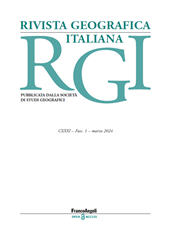Spazi informali e interstizi urbani lungo la Rotta Balcanica (1) : il refugee hub di Belgrado
48-71 p.
Il presente lavoro, frutto di ricerche sul campo sviluppatesi nell'arco di otto anni (2015-2023), intende porre in evidenza l'evoluzione, i tratti comuni e le diversità che hanno caratterizzato le città di Belgrado e Trieste nell'affrontare la medesima crisi umanitaria, quella che dall'estate del 2015 ha stravolto le politiche europee sull'immigrazione e messo a dura prova i sistemi di accoglienza locali. Per esigenze editoriali, la nostra analisi sarà proposta in due "momenti" concettualmente unitari seppur presentati in due distinti articoli: qui viene discusso il posizionamento del progetto rispetto alla letteratura esistente, la metodologia adottata e il caso di Belgrado; nell'articolo successivo (intitolato: Spazi informali e interstizi urbani lungo la Rotta Balcanica (2): Trieste Endgame e pubblicato nel prossimo numero di questa rivista) sarà presa in esame la capitale adriatica e, nelle conclusioni, si proporranno spunti di riflessione validi per il saggio nel suo complesso.
La nostra analisi si articola pertanto partendo dalla "contro-mappatura" di alcuni interstizi urbani trasformati dalla presenza di profughi e richiedenti asilo, per poi prendere in considerazione le geografie formali e informali prodotte dalle rispettive politiche dell'accoglienza messe in atto nelle due città incluso il ruolo delle autorità e delle organizzazioni umanitarie e di volontariato. [Testo dell'editore].
This paper is the result of fieldwork that has been conducted over eight years (2015-2023) along the so-called refugee "Balkan Route" and it aims to discuss the development the commonalities and the differences that have characterized two cities (Belgrade and Trieste) faced with the implications of the refugee related humanitarian crisis that, since the summer of 2015, has challenged all European immigration policies and put a strain on many local reception systems. For editorial reasons, our research will be presented in two distinct articles which are conceptually and analytically part of the same, broader, essay: therefore, in the present article we discuss the positioning of the project compared to the existing literature, the methodology and the case of Belgrade; in an article that will follow (entitled: Spazi informali e interstizi urbani lungo la Rotta Balcanica (2): Trieste Endgame, published in the next issue of this journal).
we will discuss the case of Trieste, while in the conclusion we will present the general findings of the overall project. More specifically, here we examine the ways in which refugees and asylum seekers have used, resignified and appropriated some key urban areas in Belgrade, contributing to the emergence of a refugee hub that is the result, at the same time, of the interventions of the authorities and of the humanitarian organizations, of ever changing border policies as well as of the spatial tactics of the people on the move along this informal migration corridor. [Publisher's Text].
Is part of
Rivista geografica italiana : CXXXI, 1, 2024-
Articles from the same issue (available individually)
-
Information
DOI: 10.3280/rgioa1-2024oa17376
ISSN: 0035-6697
KEYWORDS
- Belgrado, refugee hub, geografie urbane informali, Rotta Balcanica
- Belgrade, refugee hub, informal urban geographies, Balkan Route


